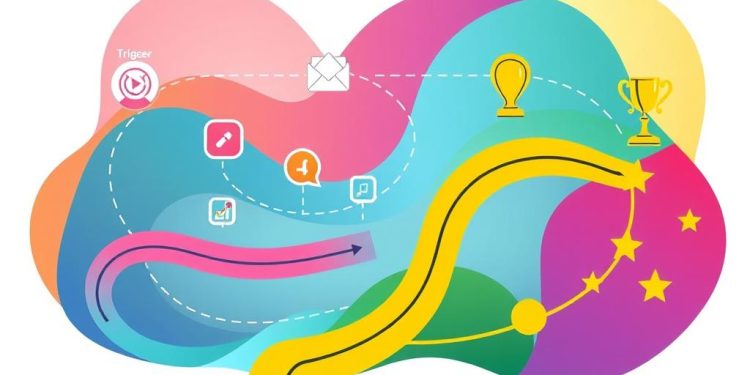Understanding habit loops is essential for transforming your daily routines. These loops, consisting of a cue, a routine, and a reward, form the foundation of habit creation. Neuroscience research indicates that nearly 40% of daily actions are habit-based, highlighting the profound impact they have on your life. The neuroscience of habits shows that behaviors become ingrained in the basal ganglia, making them automatic over time.
As you explore how to harness these loops, you’ll learn that a consistent practice of new behaviors typically requires around 66 days for them to solidify. By understanding and identifying cues for negative habits, you can consciously alter your routines, significantly enhancing your motivation and success rates in adapting your behavior patterns.
Immediate rewards following new routines can effectively reinforce positive changes, aligning with your individual motivation levels. Additionally, a supportive environment and social backing can elevate your likelihood of maintaining these new habits. Let’s delve deeper into the specific components of habit loops and discover actionable strategies to cultivate beneficial habits.
Understanding the Habit Loop: The Foundation of Habit Formation
The concept of the habit loop serves as the backbone for understanding habit formation. Formulated by Charles Duhigg, the loop encompasses three critical elements: cue, routine, and reward. Recognizing how these components interact aids in habit creation and offers insights into behavioral psychology.
Components of the Habit Loop: Cue, Routine, and Reward
The fundamental structure of the habit loop is designed to promote automatic behaviors through three integral stages. Each stage plays a unique role:
- Cue: The trigger that initiates the habit.
- Routine: The behavior or action that follows the cue.
- Reward: The positive reinforcement that helps solidify the habit.
The Role of Cues in Triggering Habits
Cues are essential in habit formation, acting as prompts that can come in various forms. These may include specific times, locations, or emotional states. For example, grabbing your phone when it buzzes or checking social media when feeling stressed reflects the interplay between cues and habits. Cues drive you toward the automatic response associated with them, creating a feedback loop that can strengthen the habit over time.
How Routines Become Automatic Actions
Routines transform into automatic actions through consistent repetition. This process aligns with the habit loop, where the routine becomes increasingly ingrained after numerous iterations. Over time, the routine shifts from the prefrontal cortex’s control to being managed by the basal ganglia, resulting in effortless execution. This automaticity not only preserves your mental energy but also reinforces the behavior as a reliable response to its associated cue.
The Importance of Rewards in Reinforcement
Rewards play a pivotal role in reinforcing habits. They come in various forms, satisfying cravings and teaching which actions are worthwhile. As the brain continuously scans for rewards, positive reinforcement solidifies the connection between the cue-routine-reward cycle. Without rewards, the habit loop fails to complete, hindering the transformation of behavior into a habit. Establishing effective rewards is crucial for sustaining motivation and commitment to habit formation.
| Component | Description | Example |
|---|---|---|
| Cue | The trigger prompting the behavior | Alarm clock goes off |
| Routine | The behavior that follows the cue | Getting out of bed |
| Reward | The positive outcome resulting from the routine | Feeling awake and energized |
How the Brain Forms Habits
Understanding how the brain forms habits provides insight into the mechanisms of habit formation. Neuroplasticity, the brain’s ability to rewire itself, plays a critical role in this process. You begin to encode new behaviors when you repeatedly engage in an action, leading to the development of brain habits that become second nature. This transformation involves both the prefrontal cortex and the basal ganglia, each serving distinct functions in habit formation.
The Neuroplasticity Process in Habit Formation
Neuroplasticity enables the brain to adapt through repeated experiences. Each time you practice a new behavior, your brain strengthens the neural pathways associated with that action. This process indicates that with persistence, what initially requires conscious effort can become automatic. As you form a habit, the mental resources needed to engage in that behavior decrease, allowing your brain to allocate its energy elsewhere.
Understanding the Role of the Prefrontal Cortex
The prefrontal cortex is vital for decision-making and planning. When you start a new habit, this area engages heavily, requiring significant mental effort. You analyze options and weigh benefits. Over time, as the behavior becomes more regular, reliance on the prefrontal cortex decreases, making way for more efficient processing. This evolution underscores the shift from intentional actions to subconscious habits.
The Basal Ganglia: The Hub of Habit Formation
The basal ganglia acts as the central hub for habit formation. It takes over once a behavior evolves into a routine, allowing automatic execution without conscious thought. Harnessing the habits established by the basal ganglia promotes efficiency in daily tasks. Repeating actions solidifies these patterns, making them integral to your lifestyle. The brain’s ability to form habits showcases the interconnectedness of its various regions collaborating to create lasting changes.
The Neuroscience of Habits and Behavior Patterns
Navigating the complexities of habit formation involves delving into habit neuroscience, where we discover how automated behaviors can profoundly influence your daily life. Understanding how habits operate on a neurological level reveals strategies to optimize your mental energy. With a clearer grasp of your emotional triggers, you can effectively reshape these ingrained patterns.
How Automated Behaviors Free Mental Energy
Automated behaviors significantly free up mental energy, allowing you to focus on more demanding tasks. Research indicates that nearly half of daily actions occur almost automatically, suggesting that the brain continually updates reward values. For instance, you may unconsciously choose chocolate over broccoli due to powerful reward pathways activated by these decisions. This process highlights why certain habits, like overeating, can mirror addictive behaviors. The prefrontal cortex can experience moments of disconnection during states of stress or fatigue, impairing decision-making and leading to reliance on habitual responses. Such reliance may further reinforce unhealthy routines, creating a cycle that detracts from overall well-being.
The Connection Between Emotions and Habit Formation
Emotions play a crucial role in habit formation. Specific emotional states often serve as cues for behaviors, meaning feelings like hunger, anger, loneliness, or fatigue can lead you towards habitual responses, including the tendency to overeat or worry. Mindfulness practices can disrupt this cycle by deactivating regions of the brain linked to cravings. As a result, you might find it easier to engage in healthier alternatives. Additionally, values-rich actions that foster meaningful relationships can bolster commitment to health behaviors, providing intrinsic rewards that reinforce positive habits over time. Recognizing this connection between emotions and automated behaviors empowers you to take charge of your habit formation process.
| Emotional State | Possible Habit Response | Effective Strategy |
|---|---|---|
| Hungry | Overeating | Mindful eating practices |
| Angry | Negative coping mechanisms | Stress management techniques |
| Lonely | Isolation | Engaging with social circles |
| Tired | Opting for convenience foods | Meal planning for energy |
Habit Loops: How to Build Better Habits
Building better habits involves implementing effective strategies that encourage consistency and motivation. By starting with small goals, you can gradually increase your chances of success. Research shows that dividing larger aspirations into manageable steps makes it easier to incorporate these changes into your daily life. An example could be simply preparing your workout clothes the night before to kickstart your routine.
Starting Small: Breaking Down Goals into Manageable Steps
Setting small goals allows you to create a solid foundation for your habit formation journey. Whether it’s dedicating just a minute to meditation after your morning coffee or taking a short walk during your lunch break, every little effort counts. Embracing the blank slate effect, as suggested by research, enables you to forge new habits in fresh environments, enhancing your likelihood of success.
Optimizing Your Cues for Consistency
Your success in developing habits heavily relies on habit cues. External prompts can significantly assist in establishing your routines during the beginning stages. Notifications, for instance from an app like XPASS, serve as reminders to guide you towards physical activity and can enforce accountability in your daily habits. Consider using specific cues, such as drinking water at specific intervals or setting bedtime alarms to support positive changes in your life.
Reinforcing Routines with Effective Rewards
Maintaining a habit requires reinforcing it with effective rewards. Acknowledge that without rewarding oneself, returning to old routines becomes a risk. External rewards, such as earning points from platforms like XPASS for completing actions, can enhance motivation. Additionally, small incentives for healthy eating, like rewarding yourself with a mini candy bar after consuming more fruits and vegetables, can also help sustain your commitment to building better habits.
Effective Strategies for Breaking Bad Habits
Breaking bad habits can often feel overwhelming, yet some effective strategies can simplify the process. Recognizing your habit cues is the crucial first step in making lasting changes. By identifying the triggers that lead to negative routines, you can develop a plan to disrupt that cycle. For example, consider how stress might prompt you to reach for unhealthy snacks. By replacing negative routines with positive alternatives, you can significantly shift behaviors toward healthier choices.
Recognizing and Hacking Your Habit Cues
Each habit starts with a cue, which could be internal, such as emotions, or external, like location. Understanding these cues helps you form a strategy to hack them. Practice mindfulness techniques to improve awareness of these triggers. With increased attention, you can devise a plan that addresses your specific cues, making behavior change more achievable. For instance, when feeling overwhelmed, instead of turning to junk food, opt for a piece of fruit or a quick workout.
Replacing Negative Routines with Positive Alternatives
Simply trying to eliminate a bad habit may not be enough to sustain long-term behavior change. Research suggests that cultivating positive alternatives is more effective than deprivation. Consider implementing healthier routines that provide similar rewards, thus maintaining motivation. This strategy not only reinforces new behaviors but also enforces a more satisfying experience, minimizing the likelihood of relapse into the negative routines you aim to break.
Creating Barriers to Unwanted Behaviors
Establishing physical barriers represents a tactical approach to breaking bad habits. This may involve removing temptations from your environment, such as charging your phone outside of the bedroom to avoid late-night scrolling. Such barriers can significantly reduce repeated engagement in unwanted behaviors. Studies reveal that preparation plays a critical role in preventing relapses. With thoughtfulness and planning, you can effectively navigate these challenges and propel yourself toward your goals.
Leveraging Environmental Factors to Support Habit Change
Your surroundings play a crucial role in shaping your habits. By adjusting environmental factors, you can effectively support habit change. A positive environment enhances the likelihood of adopting healthy habits. For example, placing fresh fruits and vegetables in visible areas of your kitchen makes it easier to choose nutritious options. In contrast, keeping unhealthy snacks out of sight can reduce the temptation to indulge in bad habits.
Enhancing Your Environment for Positive Habit Formation
Creating a conducive setting involves several strategies. Utilize the following methods to transform your space:
- Optimize visibility: Keep reminders of your goals visible to reinforce positive habit formation.
- Limit distractions: Create a dedicated space for specific activities, minimizing interruptions.
- Incorporate cues: Use visual or auditory triggers that prompt you toward desired behaviors, ensuring they align with your goals.
- Designate areas for certain activities: Establish places for exercise, relaxation, or meals to encourage specific routines.
The Power of Social Support in Behavior Change
Social interactions significantly influence your ability to maintain habits. Engaging with a supportive network can facilitate habit change. When you share your goals with friends or family, they provide accountability, encouragement, and feedback. This social support reinforces positive behaviors and helps you stay committed to your habits.
Consider these approaches to leverage social connections effectively:
- Join groups: Participate in community or online groups focused on similar goals, offering motivation through shared experiences.
- Accountability partners: Find someone who shares your objectives and can hold you accountable for your actions.
- Celebrate successes together: Acknowledge achievements with your support system to promote a sense of accomplishment.
Conclusion
The journey to mastering habit loops is a powerful step toward your personal success. By understanding the components of behavior change—cues, routines, and rewards—you have the tools needed to reshape your habits effectively. This knowledge allows you to cultivate lifelong habits that foster a healthier lifestyle while enhancing your overall well-being.
Innovative tools like Levels’ Habit Loop feature aid you in focusing on multiple aspects of your health, such as nutrition, exercise, and sleep. With the ability to track key habits—like protein intake and quality sleep—you can make informed decisions that contribute to your metabolic health. Remember, small and consistent steps are the key to long-term behavior change, which may include monitoring glucose spikes to create custom health goals tailored to your specific needs.
Ultimately, embracing your habits with awareness puts you in control. The insights gained from analyzing your routine can catalyze significant improvements over time. Whether you’re transforming a keystone habit or finding balance in your daily life, each positive change leads you closer to achieving the fulfilling life you desire.









